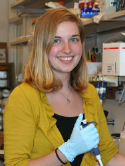Distinct but spatially overlapping intestinal niches for vancomycin-resistant Enterococcus faecium and carbapenem-resistant Klebsiella pneumoniae Journal Article
| Authors: | Caballero, S.; Carter, R.; Xu, K.; Sušac, B.; Leiner, I. M.; Kim, G. J.; Miller, L.; Ling, L.; Manova, K.; Pamer, E. G. |
| Article Title: | Distinct but spatially overlapping intestinal niches for vancomycin-resistant Enterococcus faecium and carbapenem-resistant Klebsiella pneumoniae |
| Abstract: | Antibiotic resistance among enterococci and γ-proteobacteria is an increasing problem in healthcare settings. Dense colonization of the gut by antibiotic-resistant bacteria facilitates their spread between patients and also leads to bloodstream and other systemic infections. Antibiotic-mediated destruction of the intestinal microbiota and consequent loss of colonization resistance are critical factors leading to persistence and spread of antibiotic-resistant bacteria. The mechanisms underlying microbiota-mediated colonization resistance remain incompletely defined and are likely distinct for different antibiotic-resistant bacterial species. It is unclear whether enterococci or γ-proteobacteria, upon expanding to high density in the gut, confer colonization resistance against competing bacterial species. Herein, we demonstrate that dense intestinal colonization with vancomycin-resistant Enterococcus faecium (VRE) does not reduce in vivo growth of carbapenem-resistant Klebsiella pneumoniae. Reciprocally, K. pneumoniae does not impair intestinal colonization by VRE. In contrast, transplantation of a diverse fecal microbiota eliminates both VRE and K. pneumoniae from the gut. Fluorescence in situ hybridization demonstrates that VRE and K. pneumoniae localize to the same regions in the colon but differ with respect to stimulation and invasion of the colonic mucus layer. While VRE and K. pneumoniae occupy the same three-dimensional space within the gut lumen, their independent growth and persistence in the gut suggests that they reside in distinct niches that satisfy their specific in vivo metabolic needs. © 2015 Caballero et al. |
| Keywords: | controlled study; sequence analysis; nonhuman; mouse; animal tissue; confocal microscopy; animal experiment; transplantation; antibiotic resistance; fluorescence in situ hybridization; immunofluorescence test; bacterial colonization; vancomycin resistant enterococcus; intestine flora; feces analysis; enterococcus faecium; ampicillin; klebsiella pneumoniae; bacterial load; article; fecal microbiota transplantation |
| Journal Title: | PLoS Pathogens |
| Volume: | 11 |
| Issue: | 9 |
| ISSN: | 1553-7366 |
| Publisher: | Public Library of Science |
| Date Published: | 2015-09-03 |
| Start Page: | e1005132 |
| Language: | English |
| DOI: | 10.1371/journal.ppat.1005132 |
| PROVIDER: | scopus |
| PMCID: | PMC4559429 |
| PUBMED: | 26334306 |
| DOI/URL: | |
| Notes: | Export Date: 2 November 2015 -- Source: Scopus |
Altmetric
Citation Impact
BMJ Impact Analytics
MSK Authors
Related MSK Work













